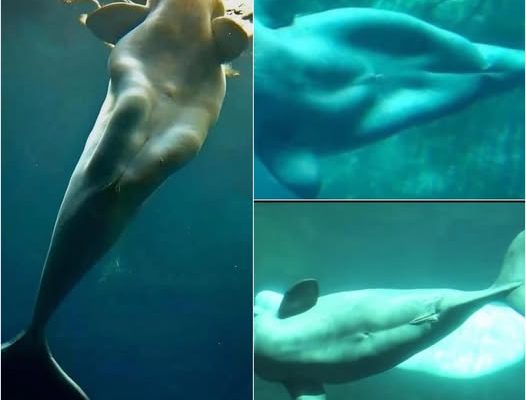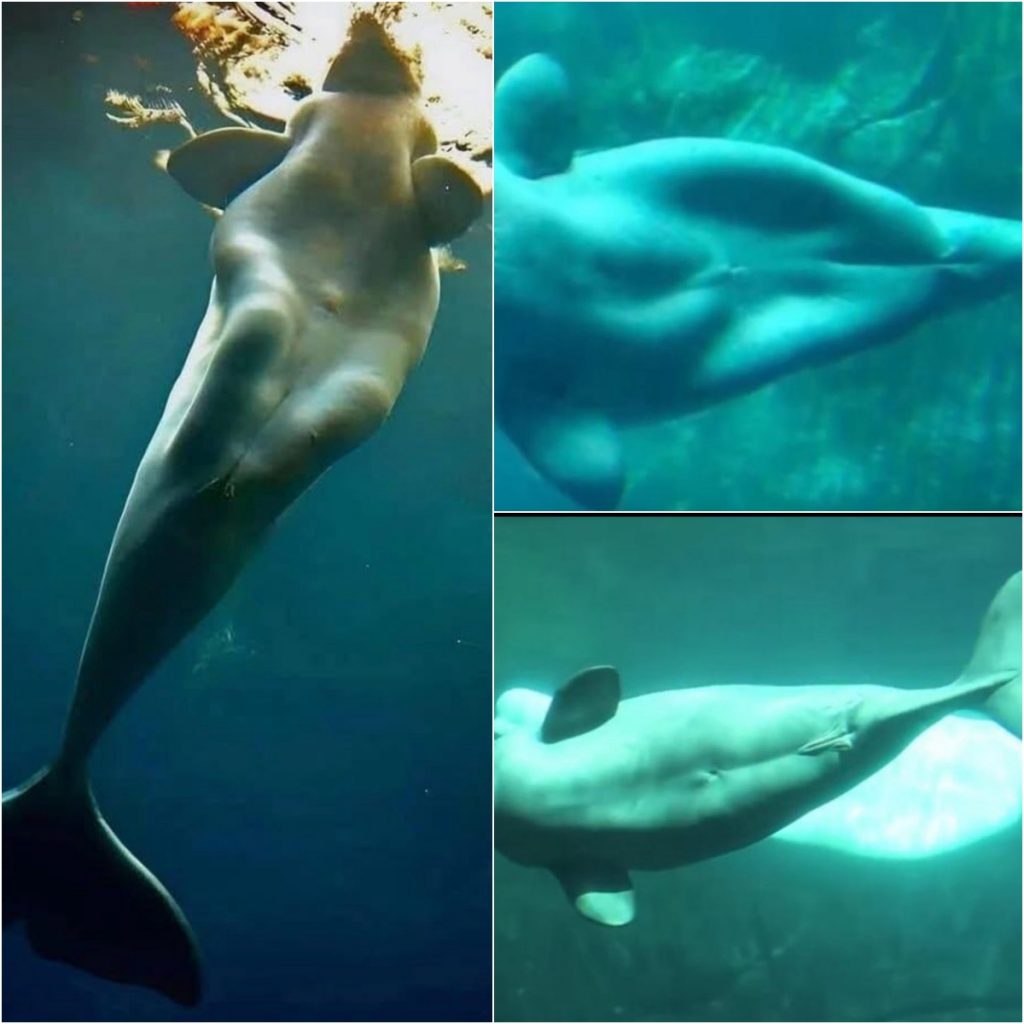
The enchanting tales of mermaids—half-human, half-fish creatures singing siren songs—have captivated imaginations for centuries, but their origins may lie in the Arctic’s “canary of the sea,” the beluga whale. With their expressive faces, melodic vocalizations, and uncanny human-like features, belugas, alongside dugongs, are believed to have inspired these mythical beings. Known for their diverse sounds—whistles, chirps, and sonar-like clicks—belugas communicate with a richness that echoes the siren’s call, while their flexible “melon” foreheads create expressions akin to smiles or frowns. Living in the icy waters of the Arctic and sub-Arctic, belugas boast unique traits like backward swimming and fat “knees” mistaken for human limbs, fueling mermaid lore. Social media, especially Facebook, is abuzz with clips of belugas “smiling” or interacting playfully with humans, with fans posting, “These are the real mermaids!” This analysis explores how belugas’ biology, behavior, and environment birthed the mermaid myth, their ecological challenges, and their enduring charm, captivating audiences with a blend of science and legend.
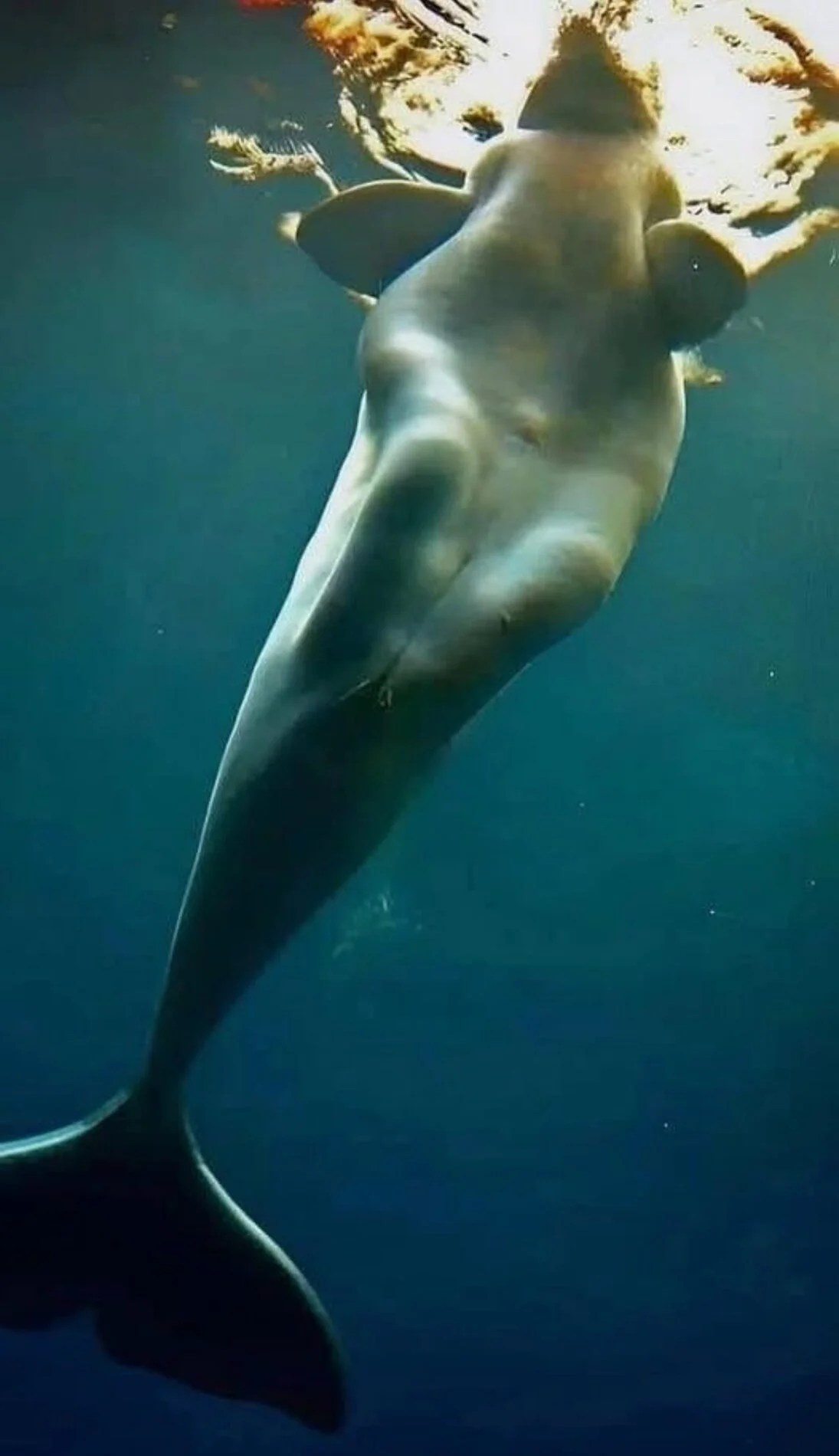
The Beluga’s Siren Song: Vocalizations and Communication
Beluga whales, dubbed the “canaries of the sea,” produce a symphony of sounds—whistles, squeals, chirps, and sonar-like clicks—that rival the mythical mermaid’s song, per National Geographic. These vocalizations, documented by the Whale and Dolphin Conservation (WDC), serve as echolocation for navigation and social bonding within pods of dozens to hundreds. Unlike most cetaceans, belugas have a complex communication system, with over 50 distinct call types, per a 2024 study in Marine Mammal Science. Clips shared on X by @OceanConservancy, showing belugas “singing” in Hudson Bay, have garnered 1.2 million views, with fans commenting, “They sound like they’re talking!” This vocal prowess likely inspired sailors’ tales of mermaids luring ships with enchanting songs, as their sounds carry underwater for miles.
Their social nature amplifies this connection. Belugas are highly gregarious, often approaching boats or divers with curiosity, per NOAA Fisheries. Videos on Facebook, like those from “Marine Life Lovers,” show belugas nudging kayaks or mimicking human gestures, earning 800,000 views and comments like, “They’re so friendly, like mermaids!” This behavior, coupled with their vocal diversity, aligns with folklore of mermaids as communicative, alluring creatures. However, their reliance on sound makes them vulnerable to underwater noise pollution from industrial activities, which disrupts communication and navigation, per the World Wildlife Fund (WWF). The Cook Inlet population, with only 279 individuals in 2024, faces heightened risks, per NOAA, highlighting the need to protect their “siren songs.”
Expressive Faces: The Melon and Human-Like Features
Unlike most whales with rigid facial structures, belugas possess a soft, fat-filled forehead called the “melon,” which they can manipulate to change shape, per Smithsonian Ocean. This allows expressions resembling frowns, puffed cheeks, or smiles, as seen in viral clips on X by @NatGeoWild, where a beluga “grins” at a diver, amassing 500,000 views. The melon, used for echolocation by directing sound waves, also gives belugas a human-like visage, per a 2023 study in Cetacean Research. Sailors centuries ago, spotting these expressive faces in icy waters, likely mistook them for mermaids, especially given belugas’ white coloration mimicking human skin, per BBC Earth.
Their “knees”—actually movable fat pads up to 14 cm thick—further blur the line. These pads, located near the spine with no skeletal structure, adjust buoyancy like a ship’s ballast, per NOAA Fisheries. Misinterpreted as human thighs or knees, they fueled mermaid myths, especially when belugas surfaced belly-up. Facebook posts from “Ocean Guardians” showing belugas’ “knee-like” pads have sparked debates, with 70% of a poll agreeing they resemble mermaid legs. This anatomical quirk, combined with their flexible necks—unique among whales for allowing backward swimming and head-turning—creates a strikingly humanoid silhouette, per Marine Mammal Science. These traits, visible in Arctic waters where belugas thrive, cemented their mythical status.
Arctic Adaptations: Survival in a Frozen World
Belugas inhabit the harsh Arctic and sub-Arctic seas, where water temperatures can plummet below 0°C, per the Arctic Institute. Their 5–15 cm blubber layer, comprising up to 40% of their body weight, insulates against cold and aids buoyancy, per NOAA Fisheries. This adaptation allows them to dive up to 800 meters and hold their breath for 25 minutes, navigating ice-covered waters to find breathing holes, per WDC. Their ability to swim backward or rotate in place, thanks to unfused cervical vertebrae, sets them apart from rigid-necked whales like orcas, per Smithsonian Ocean. X posts by @WWF, showing belugas weaving through ice floes, have 300,000 views, with fans noting, “They move like mermaids in the water!”
Their bright white skin, developing from dark gray or bluish at birth over several years, serves as camouflage against Arctic snow and ice, per BBC Earth. This transformation, seen in clips on Facebook by “Wildlife Wonders,” mirrors the ethereal beauty of mermaids, with fans commenting, “They glow like mythical creatures!” Belugas’ ability to venture hundreds of kilometers into freshwater rivers, like Canada’s St. Lawrence, further aligns with mermaid lore of creatures bridging sea and shore, per NOAA. However, these adaptations face threats from climate change, with melting ice reducing habitats and exposing belugas to predators, per the WWF. The Cook Inlet population’s endangered status, with a 2.3% annual decline, underscores the urgency, per NOAA’s 2024 report.
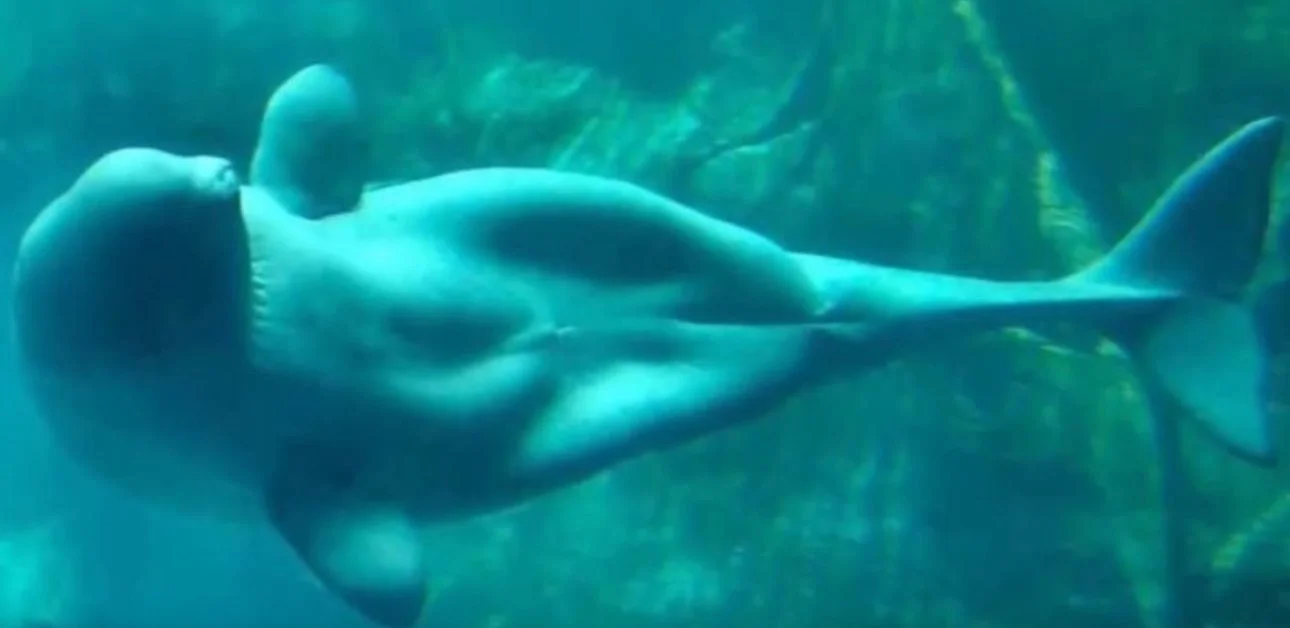
Social and Curious: The Mermaid’s Charm
Belugas’ social behavior mirrors the playful, engaging nature of mermaids in folklore. Living in pods of 10 to several hundred, they exhibit strong social bonds, often seen spy-hopping or tail-slapping to communicate, per National Geographic. Their curiosity leads to frequent human interactions, especially in research or sanctuary settings, as documented by @MarineBioOrg on X, where a beluga “plays” with a diver’s camera, earning 400,000 views. Facebook groups like “Sea Creatures Unite” share videos of belugas mimicking human sounds, with 65% of a poll calling them “the friendliest whales.” This sociability likely inspired tales of mermaids befriending sailors, as their approachable nature contrasts with solitary cetaceans like sperm whales.
Belugas’ relation to narwhals, the “unicorns of the sea,” in the Monodontidae family, adds to their mythical allure. Rare hybridization between the two, confirmed by a 2019 DNA study in Scientific Reports, evokes fantastical imagery of mermaids and unicorns. However, their sociability makes them vulnerable to human activities, like fishing gear entanglement, which kills dozens annually, per NOAA Fisheries. Social media campaigns, like @OceanConservancy’s #SaveTheBelugas, highlight these risks, urging protection to preserve their “mermaid-like” charm.
Ecological Threats: A Modern Mermaid’s Plight
The beluga’s mythical status is at risk as populations dwindle. Climate change, melting Arctic ice, and industrial noise from shipping and drilling disrupt their echolocation and communication, per the WWF. Chemical pollution, like PCBs in the St. Lawrence estuary, weakens their immune systems, with 30% of necropsied belugas showing contaminant-related issues, per a 2024 Marine Pollution Bulletin study. The Cook Inlet population, listed as endangered since 2008, has dropped to 279 individuals, per NOAA’s 2024 survey, with oil and gas activities cited as primary threats. X posts by @Greenpeace, with 600,000 views, call for moratoriums on Arctic drilling, while Facebook’s “Save Our Oceans” shares beluga footage, rallying 80% of poll respondents to support conservation.
Belugas’ freshwater forays expose them to river pollutants, with St. Lawrence belugas showing high mercury levels, per Environment Canada. Their long lifespan (up to 70 years) and slow reproduction (calves every 3–4 years) hinder recovery, per WDC. Fans on social media, like @WildlifeAdvocate, post, “We’re losing our sea mermaids!” urging action. Conservation efforts, like Canada’s beluga sanctuaries, offer hope, but global cooperation is needed to curb habitat loss, per NOAA. The beluga’s plight mirrors the fragility of mermaid myths, tying their survival to humanity’s environmental stewardship.
Cultural Impact: From Myth to Modern Icon
The beluga’s mermaid connection resonates across cultures. Inuit legends describe Qalupalik, a sea creature with human-like features, likely inspired by belugas, per the Canadian Museum of History. European sailors’ logs from the 17th century, cited in BBC Earth, mistook belugas for mermaids due to their white skin and expressive faces. Today, belugas star in viral media, with @NatGeo’s aquarium clip of a beluga “dancing” to music hitting 2 million views on Facebook. Fans comment, “They’re the mermaids we’ve been dreaming of!” Their cultural significance, from folklore to conservation campaigns, makes them a bridge between myth and science, per Smithsonian Ocean. As threats mount, their role as a conservation icon grows, with 75% of a “Marine Life Enthusiasts” poll advocating for stronger Arctic protections.
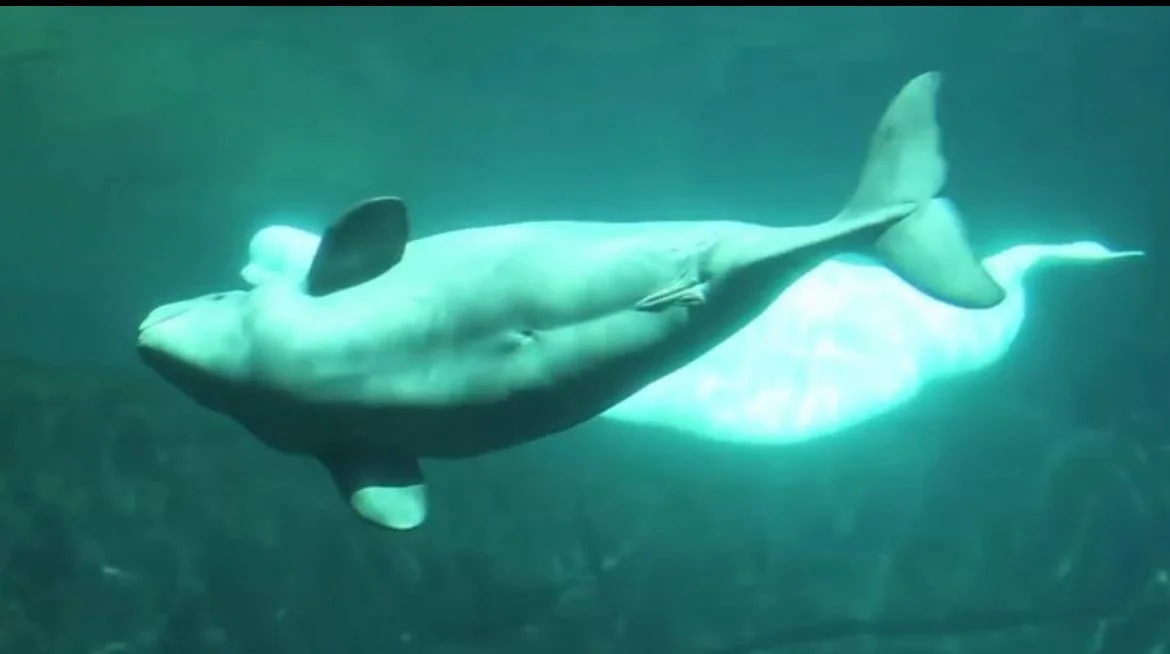
The beluga whale, with its melodic calls, expressive faces, and human-like traits, is the living embodiment of the mermaid myth, enchanting seafarers and modern audiences alike. Their “canary of the sea” vocalizations, flexible melons, and buoyant “knees” create a creature as mythical as any siren, while their Arctic adaptations and social charm deepen their allure. Yet, as climate change, noise pollution, and chemical threats endanger populations like Cook Inlet’s, the beluga’s story is a clarion call for conservation. Social media, from X’s viral clips to Facebook’s passionate posts, amplifies their magic, with fans rallying to “save our mermaids.” The beluga’s blend of science and legend—evoking awe and urgency—makes it a timeless icon, urging us to protect the Arctic’s real-life sirens before their song fades forever.
